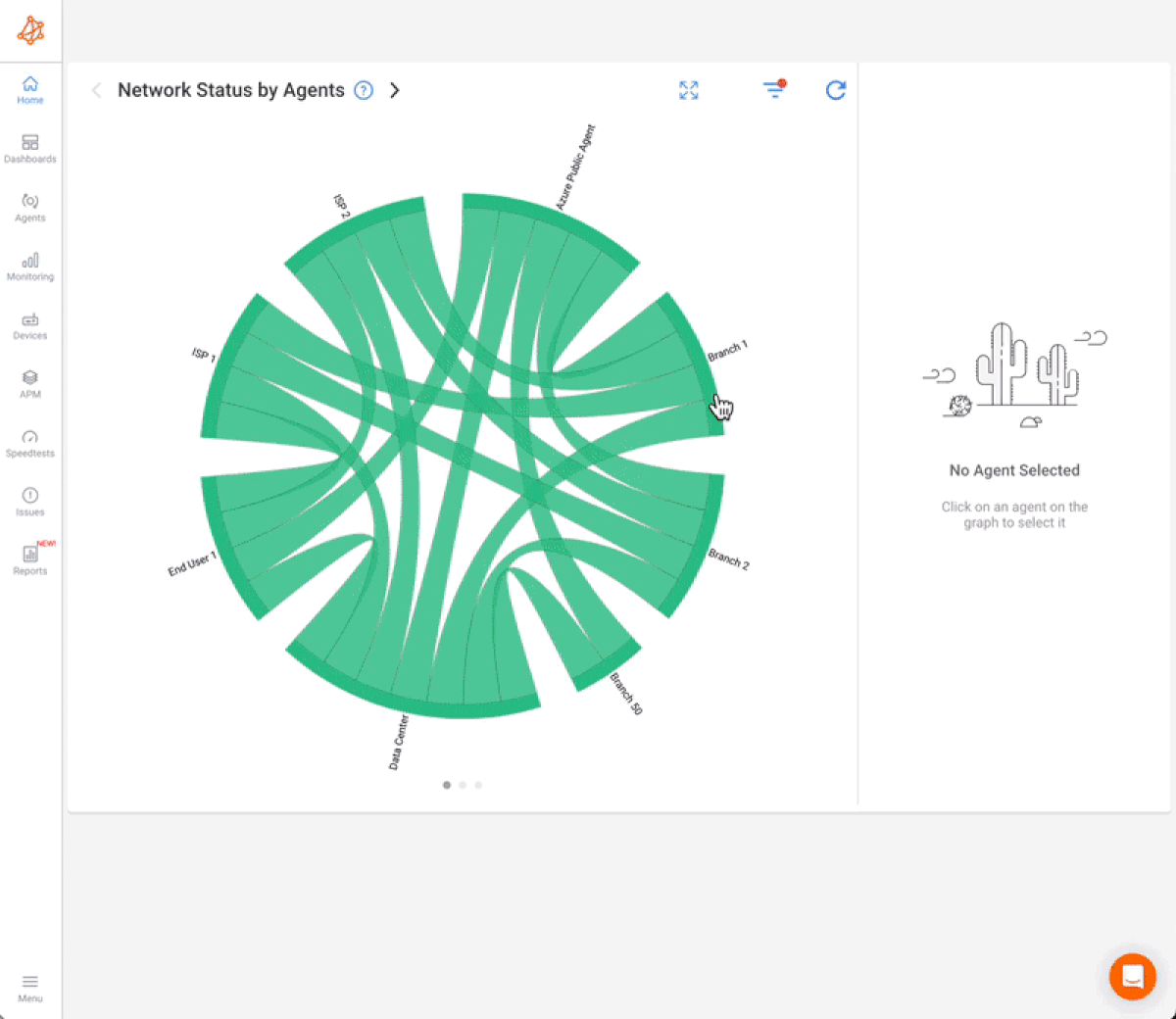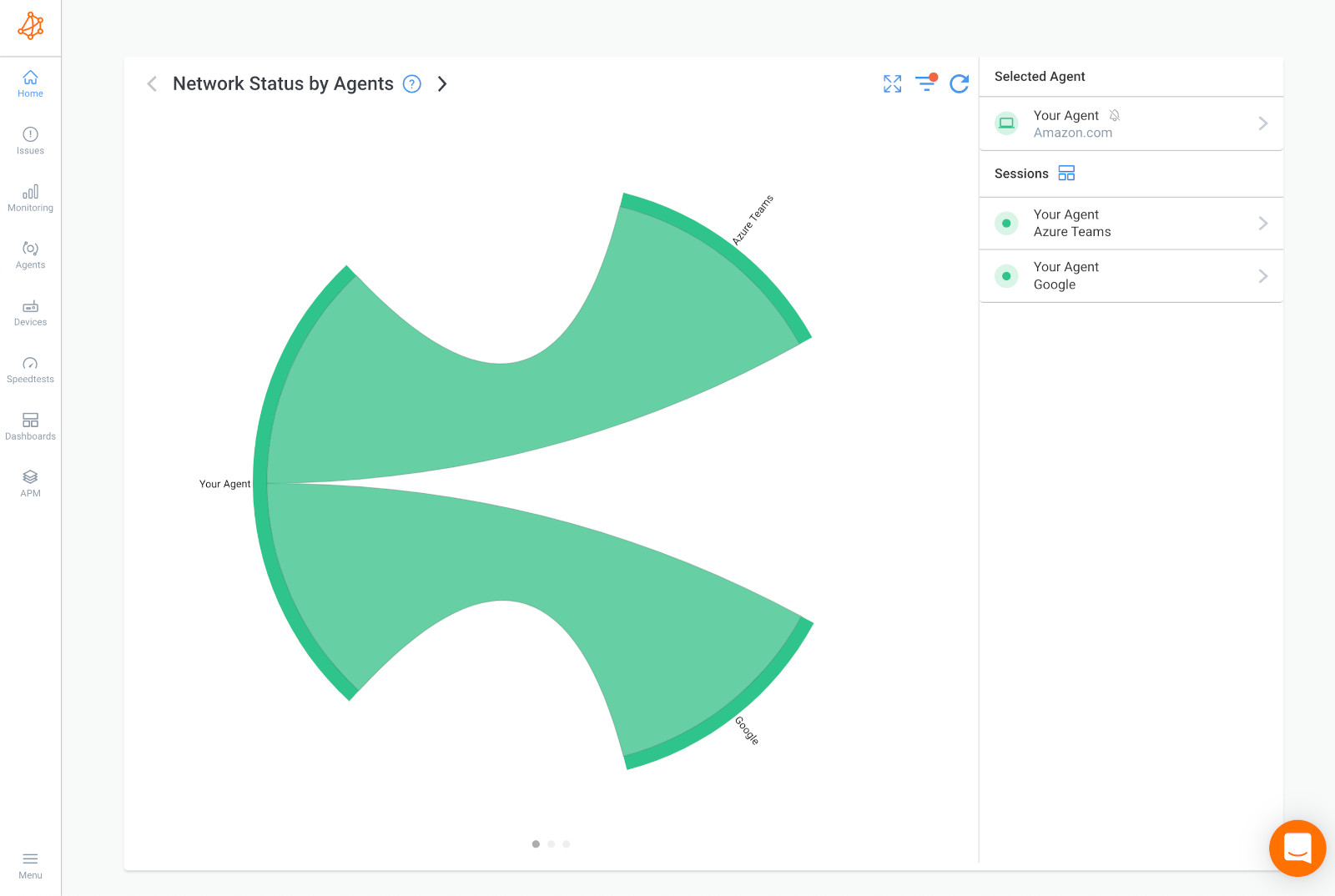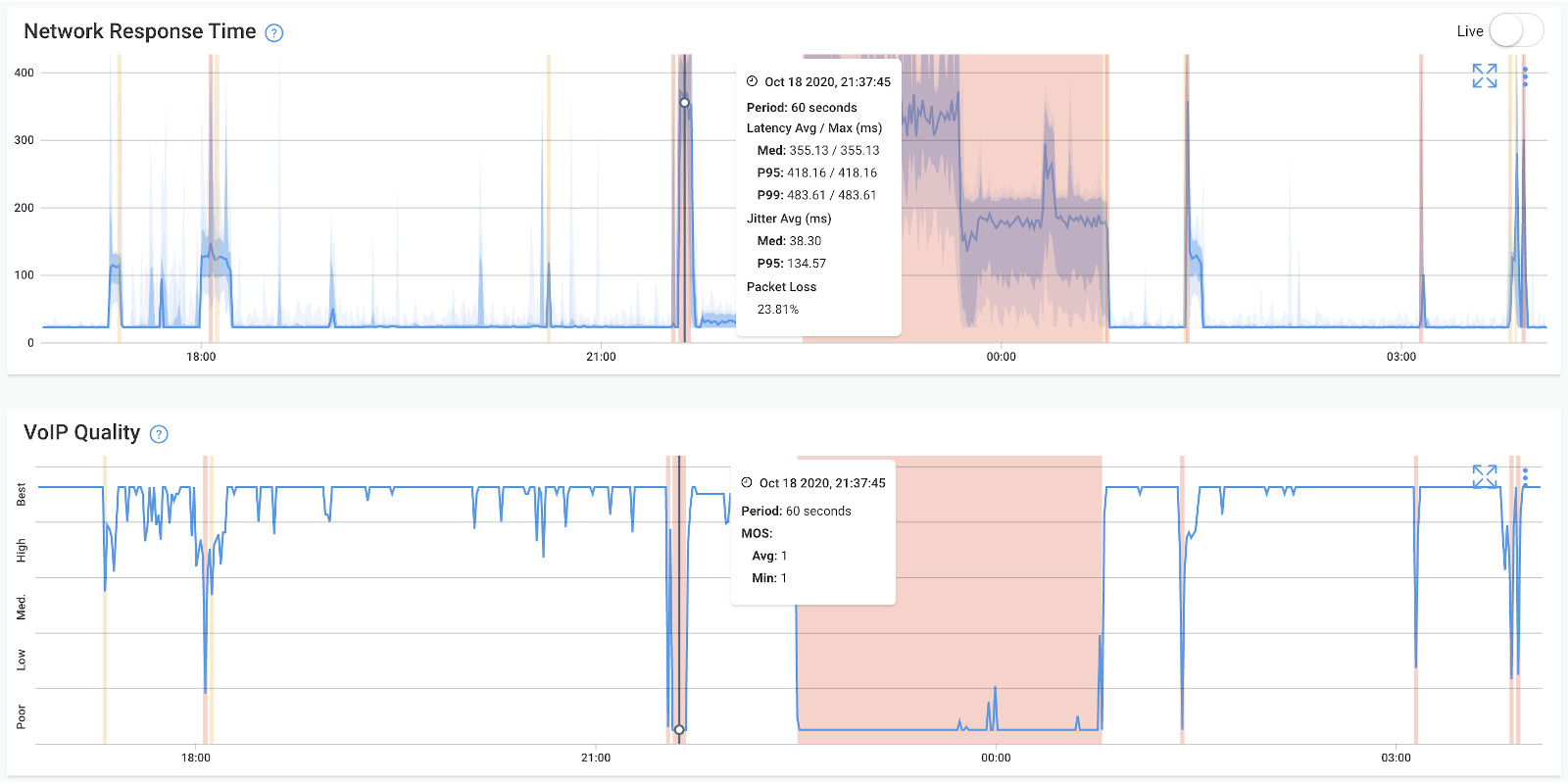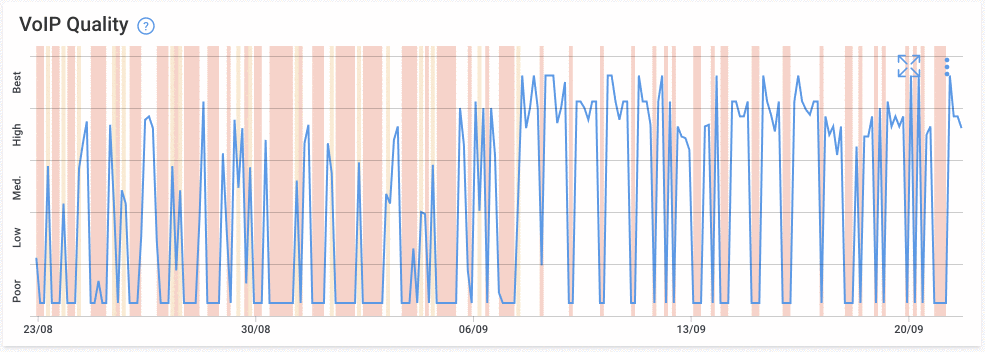Table of Contents
Table of Contents
Welcome to the world of seamless communication, where Voice over Internet Protocol (VoIP) has revolutionized the way we connect. However, amidst the convenience and clarity that VoIP promises, there's a subtle disruptor that often goes unnoticed but can significantly impact the user experience: VoIP latency.
In this article, we’ll be exploring VoIP latency—unveiling the mysterious delays that can occur during your virtual conversations. Whether you're a business relying on VoIP for daily operations or an individual seeking crystal-clear communication, understanding and addressing latency issues is crucial.
This comprehensive guide will walk you through the fundamentals of VoIP latency, helping you identify its sources, analyze its impact, and equip you with effective strategies to resolve these issues. Join us on this journey as we uncover the secrets behind VoIP latency and empower you to ensure a smooth and uninterrupted communication experience.
Certainly! Let's dive into what VoIP latency is and the different types of latency associated with Voice over Internet Protocol (VoIP).
Let’s start with a definition to get us all on the same page!
VoIP latency refers to the delay that occurs between the transmission of an audio signal and its reception during a VoIP call. In traditional telephone systems, the delay is minimal, providing users with real-time communication. However, in VoIP, which relies on data packets travelling over the internet, latency can become a concern.
Latency in VoIP is typically measured in milliseconds and is categorized into three main types:
1. Transmission Delay:
This is the time it takes for a voice signal to be converted into data packets and transmitted over the network. The process includes digitizing the analog voice signal into a digital format, compressing it (if applicable), and packaging it into data packets for transmission.
This can be caused by codec processing, packetization, and network congestion can contribute to transmission delay.
2. Propagation Delay:
Propagation delay refers to the time it takes for data packets to travel from the sender to the receiver. The speed of light in the transmission medium (such as fibre optic cables) determines this delay.
The physical distance between the communicating parties and the characteristics of the transmission medium affect propagation delay.
3. Processing Delay:
Processing delay occurs during the reception of data packets when the recipient's device processes and decodes the information. This includes the time required for depacketization, decompression (if applied), and converting the digital signal back to analog for playback.
This can be caused by device capabilities, processing power, and the complexity of decoding algorithms contributing to processing delay.
4. Jitter:
While not a type of latency per se, jitter is the variation in the delay of packet arrival. Inconsistent packet arrival times can lead to poor call quality, causing audio disruptions.
Can be caused by network congestion, varying packet sizes, and routing changes that can contribute to jitter.
Understanding these types of latency is crucial for VoIP users and administrators. High levels of latency can result in issues like echo, audio distortion, and overall degradation of call quality. Monitoring and addressing these latency factors play a vital role in ensuring a smooth and satisfactory VoIP communication experience.


Imagine you're having a VoIP conversation with a colleague using an Internet-based communication platform. Your voice is transmitted as data packets over the Internet from your device to your colleague's device.
Transmission Delay:
- When you speak into your microphone, your voice is converted into a digital format by the codec.
- The digital signal is then compressed to reduce the size of data packets.
- These compressed packets are then packaged and sent over the internet to your colleague.
- Example: If the transmission delay is 20 milliseconds, it means that from the moment you spoke into the microphone, it took 20 milliseconds for the compressed voice data to be transmitted over the network.
Propagation Delay:
- The data packets travel through the internet, which introduces a propagation delay based on the distance between your device and your colleague's device.
- This delay is influenced by the speed of light in the transmission medium (e.g., fibre optic cables).
- Example: If the propagation delay is 10 milliseconds, it means that the data packets took 10 milliseconds to travel from your device to your colleague's device.
Processing Delay:
- Upon arrival at your colleague's device, the data packets are depacketized, decompressed, and converted back into an analog signal for playback through the speaker.
- This processing takes a certain amount of time.
- Example: If the processing delay is 15 milliseconds, it means that it took 15 milliseconds for your colleague's device to process and playback the received voice data.
Total VoIP Latency:
The total VoIP latency in this scenario is the sum of the transmission delay, propagation delay, and processing delay:

So, the total VoIP latency in this scenario is 45 milliseconds. Lower latency values generally result in a more real-time and natural conversation, while higher latency can lead to noticeable delays and disruptions in communication.
Are you tired of dealing with frustrating VoIP latency issues? Unlock the power of seamless communication with Obkio's Network Performance Monitoring tool.
With Obkio, you can dive deep into the intricacies of your network, allowing you to precisely identify latency sources. Whether it's transmission delays, propagation hurdles, or processing bottlenecks, Obkio's detailed analysis empowers you to understand and address the specific issues impacting your VoIP calls.

- Identify Latency Sources: Pinpoint the root causes of VoIP latency with Obkio's detailed analysis. Gain insights into transmission, propagation, and processing delays affecting your calls.
- Measure Latency Metrics: Harness the precision of real-time latency metrics. Obkio provides you with accurate measurements, allowing you to monitor and optimize your network for crystal-clear communication.
- Troubleshoot Effectively: Tackle latency head-on with Obkio's troubleshooting capabilities. Diagnose issues swiftly, implement targeted solutions, and enjoy uninterrupted VoIP conversations.
Experience Clarity, Not Latency!

VoIP technology has revamped the way we stay connected, offering cost-effective and feature-packed communication over the Internet. Yet, the sneaky presence of latency can throw a curveball into the user experience, setting off a chain reaction of issues that disrupt the seamless flow of communication.
Understanding how VoIP latency affects communication is essential for both individuals and businesses relying on this technology. Here are key aspects:
Delay in Conversations: VoIP latency manifests as delays in voice transmission. When there's a noticeable gap between speaking and hearing, it can disrupt the natural flow of conversation, making communication less fluid.
Echo and Distortion: High latency can result in echoes or distortions during calls. This can be disorienting for users and contribute to a perception of poor call quality.
Interrupted Flow: Latency can cause jitter or packet loss, leading to a choppy or interrupted flow of conversation. This can be particularly problematic in situations that require real-time interaction, such as interviews, negotiations, or urgent discussions.
Frustration and User Disengagement: Persistent latency issues can lead to frustration among users. Over time, this frustration may result in disengagement or a reluctance to rely on VoIP for critical communication needs.
Addressing VoIP latency is not just a technical consideration; it's a strategic imperative for ensuring the effectiveness of communication tools in our interconnected world. By proactively identifying, measuring, and mitigating latency issues, users can unlock the full potential of VoIP, enjoying the clarity and efficiency it promises.

Now that we know how VoIP latency affects your communications, let’s briefly go over why you need to troubleshoot it ASAP:
Quality of Service (QoS): VoIP latency directly influences your communication's Quality of Service (QoS). Users expect real-time, clear conversations, and any delay can result in degraded call quality, leading to frustration and a diminished overall experience.
User Productivity: In a business context, where VoIP is often a cornerstone of daily operations, latency can hamper productivity. Delays in voice transmission can lead to miscommunications, misunderstandings, and ultimately hinder the efficiency of collaborative efforts.
Customer Experience: For businesses providing customer support or engagement through VoIP, latency can directly impact the customer experience. Long delays, echoes, or disruptions during calls can create a negative impression and erode customer satisfaction.
Collaboration and Teamwork: In an era where remote work and virtual collaboration are prevalent, VoIP serves as a lifeline for teams. Latency can hinder real-time collaboration, impeding the flow of ideas and impacting the effectiveness of virtual meetings.
Learning how to measure VoIP latency is key to ensuring smooth and uninterrupted communication and understanding how much latency is affecting your VoIP calls. Various network metrics come into play, offering insights into different facets of delay during a VoIP call. Let's explore the key measurements and considerations that unveil the intricacies of VoIP latency, from round-trip time to call setup duration.
VoIP latency is typically measured using several key metrics to assess the different aspects of delay that can occur during a VoIP call. Here are some common metrics used to measure VoIP latency:
1. Round-Trip Time (RTT):
RTT measures the time it takes for a signal (or packet) to travel from the sender to the receiver and back again. It encompasses both the transmission delay and the propagation delay.
- Measurement: The RTT value is usually expressed in milliseconds (ms).
- Formula: RTT = Transmission Delay + 2 * Propagation Delay + Processing Delay
2. One-Way Latency:
Latency focuses on the time it takes for a signal to travel from the sender to the receiver without considering the round trip. It provides a more specific measurement of the delay experienced in one direction.
- Measurement: Like RTT, one-way latency is expressed in milliseconds.
- Formula: One-Way Latency = Transmission Delay + Propagation Delay + Processing Delay
3. Jitter:
Jitter measures the variation in packet arrival times. It reflects the irregularities in the delay between received packets, which can contribute to call quality issues.
- Measurement: Jitter is typically measured in milliseconds.
- Formula: Jitter = Variance of the inter-arrival time of packets
4. Packet Loss:
Packet loss indicates the percentage of data packets that fail to reach their destination. Excessive packet loss can result in degraded call quality.
- Measurement: Packet loss is presented as a percentage.
- Formula: Packet Loss Percentage = (Number of Lost Packets / Total Number of Packets) * 100
5. MOS Score (Mean Opinion Score):
MOS is a subjective measurement based on user feedback that quantifies the perceived quality of a VoIP call. It considers factors such as latency, jitter, and packet loss.
- Measurement: MOS scores range from 1 to 5, with higher values indicating better call quality.
- Formula: MOS Score is derived from subjective user ratings and isn't calculated using a specific formula. It is often determined through user surveys or testing.
6. Call Setup Time:
Call setup time measures the time taken to establish a connection before the actual conversation begins. Excessive setup time can impact the user experience.
- Measurement: Call setup time is typically measured in seconds.
- Formula: Call Setup Time = Time taken to establish the call connection.
7. End-to-End Delay:
End-to-end delay encompasses all the delays experienced from the moment a user speaks into the microphone to when the voice is heard by the recipient.
- Measurement: Like other latency metrics, end-to-end delay is expressed in milliseconds.
- Formula: End-to-End Delay = Transmission Delay + Propagation Delay + Processing Delay + Jitter Buffer Delay + Network Queuing Delay
These metrics collectively offer a comprehensive view of the latency characteristics in a VoIP system. Monitoring tools and platforms use these measurements to assess the health of the network and identify areas for improvement to ensure optimal VoIP call quality.
So how exactly do monitoring tools monitor these metrics to measure VoIP latency? Well, you’re in luck because we’re diving into that next!
Learn how to measure latency with Obkio’s Network & Latency Monitoring tool. Check for latency in your network & analyze latency measurements.
Learn more

Imagine your network as a bustling expressway where VoIP conversations speed along, racing towards their destinations. Just like a well-tuned engine, smooth communication requires precision and efficiency. However, now and then, the expressway can encounter traffic jams, detours, or the occasional pothole, slowing down your VoIP journey.
Enter network monitoring tools – the superheroes of the digital highway! Think of them as your trusty GPS, guiding you through the lanes and alerting you to potential roadblocks. These tools not only map out the entire expressway but also analyze the traffic flow, ensuring that your VoIP conversations cruise smoothly without any unexpected pit stops.
Network monitoring tools offer real-time insights into your network's performance, making them ideal for measuring VoIP latency. Key benefits include proactive issue detection, comprehensive data collection on latency metrics, end-to-end visibility, and historical data analysis. With troubleshooting capabilities and a focus on Quality of Service (QoS), these tools enhance user experience by quickly identifying and addressing VoIP latency issues, ensuring smooth and uninterrupted communication.
With so many Network Monitoring tools out there, it’s hard to know where to start. So, let’s give you a hand.
VoIP Latency issues aren’t really network problems that you can see. So you need help to get the visibility you need to identify and fix it. - mostly because it makes you sound like a robot during VoIP calls.
The most accurate way to identify and troubleshoot VoIP latency is by using a tool like Obkio Network Performance Monitoring Software.

Obkio stands out as an advanced network performance monitoring tool crafted to consistently identify and troubleshoot latency issues anywhere in your network. By sending and monitoring synthetic traffic at 500 ms intervals (equivalent to half a second), Obkio can more effectively identify VoIP latency issues as soon as they happen.
By continuously monitoring performance, Obkio allows you to detect any deviations in delay or or latency that might impact the performance of VoIP or UC applications. The gathered data serves as the foundation for calculating essential metrics, including latency, essential for sustaining an optimal network environment.
Obkio's goes beyond latency monitoring, offering a complete view of network performance. Obkio 's all-encompassing network monitoring tool not only pinpoints variations in latency but also furnishes valuable insights into network congestion, packet loss, jitter, and the overall health of the network.

Obkio identifies VoIP jitter using continuous synthetic traffic from Network Monitoring Agents deployed in your most important network locations like offices, data centers and clouds. The Agents identify latency issues in your network by sending and monitoring data packets through your network every 500ms.
This is extremely important for identifying even the smallest amount of VoIP latency since VoIP is especially sensitive to network issues.
To deploy VoIP latency monitoring in all your network locations, we recommend deploying:
- Local Agents: Installed in the targeted office location experiencing VoIP latency issues. There are several Agent types available (all with the same features), and they can be installed on MacOS, Windows, Linux and more.
- Public Monitoring Agent: These are deployed over the Internet and managed by Obkio. They compare performance up to the Internet and quickly identify if the latency issue is global or specific to the destination. For example, measure VoIP latency between your head office and a user’s remote workstation in another location.

Once you’ve set up your Monitoring Agents, they will start measuring key network metrics like latency and collecting data, which you can easily analyze on Obkio’s Network Response Time Graph.
Identify and measure latency anywhere in your network, especially latency issues affecting VoIP and UC applications, with updates every minute. You can also further drill down to identify where exactly the VoIP latency is happening and start troubleshooting network issues.

We’ll dive into this a little more later on in the article but, when you’re measuring VoIP latency, it’s important to understand how much latency can affect VoIP performance. Acceptable latency for VoIP is typically considered to be around 150 milliseconds (ms) or lower. However, the specific threshold for acceptable latency can depend on the nature of the communication and user preferences. Here are some general guidelines:
- 150 ms or Lower: For most VoIP applications, a latency of 150 ms or lower is considered acceptable. This level of latency is often imperceptible to users, resulting in a natural and real-time conversation experience.
- Up to 250 ms: Latency between 150 ms and 250 ms is still generally acceptable for standard voice communication. Users may notice a slight delay, but it typically does not significantly impact the conversation.
- 250 ms to 400 ms: In this range, users may experience noticeable delays and a slightly degraded user experience. While communication is still possible, it may not be ideal for time-sensitive or interactive conversations.
- Above 400 ms: Latency above 400 ms can lead to significant communication challenges. Users are likely to experience delays, interruptions, and potential difficulties in understanding and responding in real-time.
It's important to note that acceptable latency levels can vary based on the type of communication. For instance, real-time collaboration tools, such as video conferencing or online gaming, may have stricter latency requirements compared to a standard voice call.
Aside from measuring VoIP latency itself, another way to proactively identify VoIP and network issues is to measure VoIP Quality. VoIP Quality refers to the clarity, reliability, and overall performance of voice calls made over a VoIP system.
Obkio’s Network Monitoring tool continuously monitors VoIP quality using a standardized rating system called MOS (Mean Opinion Score), which rates the quality of a voice call on a scale of 1 to 5. MOS scores are calculated based on subjective ratings from human listeners who rate the call quality based on factors such as clarity, background noise, and echo.
Since many people are not very familiar with the MOS Score and the interpretation of MOS in VoIP Quality, Obkio redesigned the MOS Score graph to create the VoIP Quality graph. Obkio’s MOS VoIP Quality graph categorizes, for every minute, the MOS Call Quality as
- Best
- High
- Medium
- Low
- or Poor

The exact MOS Voice Quality Score is always available in the graph tooltip.

Obkio's capabilities extend beyond real-time monitoring, allowing users to set alerts for VoIP latency issues and analyze historical VoIP latency measurements.
By leveraging Obkio's alerting and historical analysis features, users can proactively identify and troubleshoot VoIP latency issues before they greatly impact call quality. Setting alerts ensures that deviations from acceptable latency levels are promptly identified, while historical analysis provides a retrospective view for informed decision-making and long-term optimization strategies.
Obkio's network monitoring tool stores historical performance data, allowing users to analyze trends and patterns over time. This feature enables administrators to track changes in VoIP latency, identify recurring issues, and make informed decisions for long-term optimization.
Obkio's system includes automatic network monitoring alerts that promptly notify administrators when specific thresholds or anomalies related to VoIP latency are detected. This proactive approach allows for swift responses to emerging issues, helping maintain a stable and high-quality VoIP communication environment.
By combining historical data analysis with automatic alerts, Obkio empowers users to take a proactive stance in managing VoIP latency. This approach not only facilitates effective troubleshooting but also contributes to the continuous improvement of network performance for optimal VoIP experiences.
In the quest for flawless VoIP communication, it's crucial to unveil the factors contributing to latency. This chapter delves into the intricacies of VoIP latency by dissecting network issues, codec choices, the impact of jitter and packet loss, and the influence of hardware and software. By understanding and pinpointing these sources, administrators can pave the way for efficient troubleshooting and optimization, ensuring a seamless and responsive VoIP experience.
1. Network Issues:
Network issues are a common culprit behind VoIP latency. Congestion, bandwidth limitations, and routing inefficiencies can lead to delays in transmitting voice data packets.
Users may experience increased round-trip times, packet loss, and jitter, resulting in a less responsive and clear communication experience.
Network monitoring tools, like Obkio, play a crucial role in identifying network problems by tracking metrics such as latency, packet loss, and overall network performance.
2. Codec Selection:
Codecs are responsible for compressing and decompressing voice data for transmission over the network. Codec selection directly influences the amount of data transmitted and the efficiency of the VoIP call.
Inefficient codec choices can contribute to higher bandwidth usage and increased transmission delay.
Analyzing codec configurations and their impact on network resources can help identify inefficiencies. Monitoring tools provide insights into codec performance and their influence on VoIP latency.
3. Jitter and Packet Loss:
Jitter is the variation in packet arrival times, while packet loss refers to the percentage of data packets that fail to reach their destination. Both contribute to irregularities in VoIP transmission.
Jitter and packet loss can result in choppy audio, echoes, and disruptions during calls, significantly affecting call quality. Monitoring tools, such as Obkio, measure and analyze jitter and packet loss, helping administrators pinpoint issues and take corrective measures.
4. Hardware and Software Factors:
The hardware and software components of both the sender's and receiver's devices can influence VoIP latency. Insufficient processing power, outdated firmware, or software conflicts may contribute to delays.
Hardware and software issues can lead to increased processing delay, affecting the overall responsiveness of VoIP calls. Regular maintenance, firmware updates, and performance monitoring help identify and address hardware and software issues. Monitoring tools can track device performance metrics and highlight potential areas of concern.
We asked a supercomputer “What is latency”, its impact on network performance, and strategies for minimizing it and created this comprehensive guide.
Learn more

Now let’s talk about VoIP latency requirements. From the sweet spot of acceptable latency to the secrets of low latency and the limits we set for our virtual conversations, understanding the different latency VoIP requirements is essential. It's the key to ensuring your VoIP calls aren't being affected by latency issues.
For example, when data takes its journey from Western USA to Western Europe via Google's servers, the average latency clocks in at approximately 140 ms or 0.140 seconds.
Now, here's the deal: the lower the latency, the quicker your application loads, making your overall experience smoother. On the flip side, as latency increases, users might find themselves tapping their feet in impatience and feeling a tad frustrated.
Now, patience is a virtue, right? But when it comes to certain internet functions, especially something as time-sensitive as VoIP communications, a longer wait time isn't just a minor inconvenience—it can be the make-or-break factor for success or failure.
So, you're in the realm of VoIP, and you're probably wondering, "How much latency is considered cool for a smooth conversation?" Let's dive into the sweet spot, where delays are practically invisible, making your VoIP experience feel as natural as face-to-face chit-chat.
Acceptable latency for VoIP is generally considered to be around 150 milliseconds (ms) or lower. This level ensures a near-real-time communication experience, where delays are imperceptible to users.
- Impact: Latency within this range facilitates natural conversations and maintains a high-quality user experience.
- Requirements: Applications such as voice calls, video conferencing, and online collaboration typically aim for latency within the acceptable range to ensure optimal performance.
Now, we're talking about the magic ingredient that makes VoIP truly sing - low latency. Imagine a world where your voice travels through the digital airwaves with lightning speed, creating a seamless and responsive communication experience. That's the goal, and we're here to unpack why low latency is the key to unlocking the full potential of VoIP.
VoIP systems strive for low latency to achieve clear and responsive communication. Good latency is crucial for real-time applications where interactions demand minimal delays.
Low latency for VoIP is generally considered to be around 20 to 50 milliseconds (ms). For VoIP, achieving low latency is crucial for maintaining a real-time and natural conversation experience. When latency is within this range, users typically perceive minimal delays between speaking and hearing, making the communication feel seamless.
While the acceptable latency threshold for VoIP is commonly set at 150 ms or lower, aiming for even lower latency, such as in the 20 to 50 ms range, is optimal. This ensures that users experience minimal disruptions, clear audio quality, and an overall high level of satisfaction during VoIP calls.


Every good thing has its limits, and VoIP is no exception. We're exploring the thresholds of VoIP latency - the maximum delay that keeps our conversations crisp and clear. From the sweet spot of 150 milliseconds to the application-specific demands, let's navigate the limits that keep our VoIP experiences top-notch.
The latency threshold in VoIP refers to the maximum acceptable delay beyond which communication quality may degrade. While 150 ms is commonly accepted, specific applications or industries may have more stringent latency requirements. For example, online gaming or financial trading platforms often aim for even lower latency thresholds to ensure optimal performance.
So, is there a red line when it comes to VoIP latency? The maximum acceptable delay depends on the needs of your application or service.
The maximum acceptable latency for VoIP depends on the specific requirements of the application or service. Some applications may tolerate higher latency levels, while others, especially those requiring real-time interactions, demand stricter limits.
It's important to note that while VoIP can still function with higher latencies, delays beyond a certain point become more noticeable and can impact the user experience. As latency increases:
- 150 ms or Lower: Generally considered acceptable for standard VoIP communication.
- 150 ms to 250 ms: Users may start to notice delays, but communication remains feasible.
- 250 ms and Above: Higher latencies can lead to more significant disruptions, impacting the quality and responsiveness of VoIP calls.
VoIP is a dance, and sometimes, there might be a bit of a delay. How much can your system handle before things get a bit out of rhythm? Let's chat about VoIP latency tolerance - the adaptability factor that keeps the communication flow going, even when the tempo changes.
VoIP latency tolerance refers to the extent to which a system or application can withstand delays without a significant impact on performance. Tolerance levels vary among different VoIP services, with some designed to adapt better to higher latency conditions through buffering and error correction mechanisms.
1. Factors Influencing VoIP Latency Tolerance:
Application Type: Different VoIP applications may have varying levels of tolerance for latency. For example, casual voice calls might tolerate slightly higher latency compared to real-time collaboration tools or online gaming platforms that demand low-latency interactions.
User Expectations: User expectations play a pivotal role in determining tolerance levels. Applications catering to users who prioritize real-time, interactive communication may need to maintain lower latency tolerance to meet user expectations.
Quality of Service (QoS) Settings: QoS configurations on networks can influence how well a VoIP system adapts to latency. Prioritizing VoIP traffic and allocating sufficient bandwidth can enhance the system's ability to tolerate latency variations.
Error Correction Mechanisms: VoIP systems often incorporate error correction mechanisms, such as jitter buffers and packet loss concealment, to mitigate the impact of latency. The effectiveness of these mechanisms contributes to the system's overall latency tolerance.
2. Strategies for Managing VoIP Latency Tolerance:
- Adaptive Bitrate Encoding: Adaptive bitrate encoding allows VoIP systems to dynamically adjust the quality of the audio stream based on network conditions. Lowering the bitrate during periods of high latency helps maintain a smoother communication experience.
- Buffering: Jitter buffers in VoIP systems are designed to temporarily store incoming voice packets, smoothing out variations in packet arrival times. Properly configured jitter buffers contribute to the system's ability to tolerate latency.
- Forward Error Correction (FEC): FEC is a technique that adds redundant information to transmitted packets, allowing the receiver to correct errors caused by packet loss or corruption. This enhances the system's ability to tolerate latency-related issues.
- Dynamic Routing: Dynamic routing algorithms can redirect VoIP traffic through the most efficient network paths in real-time. This adaptability helps manage latency tolerance by avoiding congested or suboptimal routes.
Understanding VoIP latency requirements is crucial for delivering a satisfactory user experience. Striking a balance between acceptable latency, low latency, and specific latency thresholds ensures that VoIP applications meet the demands of real-time communication while adapting to the unique requirements of diverse use cases. As technology advances, the pursuit of even lower latencies remains a constant goal to enhance the efficiency and immediacy of VoIP communication.

Ah, the delicate dance of VoIP - where every millisecond matters in ensuring a seamless conversation. In this section, we’re going to be diagnosing VoIP latency issues. It's the investigative phase where we unravel the mysteries behind disruptions, delays, and distorted voice quality.
Let's shine a spotlight on the culprits affecting your VoIP calls and discover how to restore that crystal-clear communication experience.
Welcome to the detective's guide for VoIP latency issues! In this section, we'll walk you through a strategic step-by-step process to uncover the root causes behind those pesky call quality problems. From recognizing symptoms to isolating devices and scrutinizing network configurations, get ready to unravel the mystery of VoIP latency.
Step 1. Identify Symptoms:
Begin by identifying the symptoms of VoIP latency issues. This could include call quality complaints, delays in audio transmission, or instances of choppy or distorted voice. Recognizing these symptoms is the first step in understanding that there might be a latency issue affecting VoIP performance.
Step 2. Collect Network Data
Utilize network monitoring tools, like Obkio, to collect comprehensive data on network performance. Gather metrics such as latency, jitter, packet loss, and overall network health. Network data provides a holistic view of the network's behavior, helping identify potential bottlenecks or irregularities impacting VoIP.
Step 3. Analyze Call Records:
Examine call records and logs to identify patterns associated with latency-related issues. Look for specific times or conditions when latency tends to spike. Call records offer valuable insights into the correlation between call quality issues and network behavior, aiding in pinpointing the root cause.
Step 4. Assess Network Configuration:
Review the configuration of network devices, routers, and switches. Ensure that Quality of Service (QoS) settings are optimized for VoIP traffic prioritization. Inadequate QoS configurations or network misconfigurations can contribute to latency. Assessing network settings helps identify and rectify potential configuration issues.
Step 5. Isolate Devices and Segments:
Isolate specific devices or network segments to identify the source and causes of latency. This may involve testing different routes or bypassing certain network components. Isolation helps narrow down the scope of the issue, facilitating targeted troubleshooting and resolution.
In this guide, learn how to troubleshoot and improve network latency with fun analogies, step-by-step instructions, and tips for both users and businesses.
Learn more

It's time to put VoIP latency under the microscope! Let’s look at crucial tests designed to measure and dissect the latency affecting your calls. From Round-Trip Time (RTT) assessments to scrutinizing jitter and packet loss, each test is a key to unlocking the secrets behind a seamless VoIP experience.
- Round-Trip Time (RTT) Measurement:
Conduct RTT tests to measure the time it takes for a signal to travel from the sender to the receiver and back. Elevated RTT values indicate latency. RTT measurements offer a direct assessment of the overall delay in the communication path.
- Jitter and Packet Loss Testing:
Perform tests specifically focused on jitter and packet loss. Excessive jitter and packet loss can contribute to choppy or disrupted audio in VoIP calls. Identifying patterns of jitter and packet loss helps in understanding the impact on call quality and potential causes.
- Quality of Service (QoS) Assessment:
Evaluate the effectiveness of QoS settings. Ensure that VoIP traffic receives appropriate prioritization to minimize latency. QoS is instrumental in maintaining low-latency conditions for VoIP calls. Assessing QoS configurations helps optimize network settings.
- End-to-End Testing:
Conduct end-to-end testing to simulate real-world VoIP calls. Assess the performance of the entire communication path, including endpoints and network infrastructure. End-to-end testing validates the overall functionality of VoIP systems and identifies potential latency-related challenges.
By systematically following a step-by-step diagnosis process and employing VoIP latency tests, administrators can identify, analyze, and address latency issues affecting VoIP communication. This proactive approach ensures a more stable and satisfactory VoIP experience for users.
Now it’s time to actually unveil the issues you’ll be encountering! VoIP latency issues refer to delays in the transmission of voice data packets during Voice over Internet Protocol (VoIP) communication. These delays can negatively impact the user experience by introducing disruptions, distortions, or interruptions in voice calls.
Let’s go over some common VoIP latency issues:
- Packet Loss: Packet loss occurs when some data packets fail to reach their destination. It can lead to gaps or distortions in audio, causing a degraded voice quality. High packet loss rates can significantly impact VoIP calls, making it challenging for users to understand each other.
- Jitter: Jitter is the variation in the time it takes for voice packets to reach their destination. It results in uneven spacing between packets, leading to choppy or uneven audio playback. Excessive network or Internet jitter can disrupt the smooth flow of conversation, introducing irregularities and making communication less natural.
- High Round-Trip Time (RTT): Round-Trip Time is the total time it takes for a voice packet to travel from the sender to the receiver and back. High RTT values contribute to noticeable delays in conversation. Prolonged round-trip times can cause conversations to feel sluggish, with noticeable delays between speaking and hearing.
- Network Congestion: Congestion occurs when there is an excessive demand for bandwidth on a network, leading to delays in packet transmission. Network congestion can result in increased latency, affecting the overall quality and responsiveness of VoIP calls.
- Inadequate Quality of Service (QoS) Settings: QoS settings prioritize different types of traffic on a network. Inadequate VoIP QoS configurations may fail to prioritize VoIP traffic, leading to latency issues. Without proper QoS, other data on the network may compete with VoIP traffic, causing delays and potential call quality degradation.
- Codec Selection: Codecs are responsible for compressing and decompressing voice data. Inefficient codec choices can lead to increased latency. Improper codec selection may result in higher bandwidth usage and delays in transmitting voice data, affecting call quality.
- Hardware and Software Limitations: Insufficient processing power or outdated firmware on network devices, routers, or endpoints can contribute to latency. Hardware and software limitations can result in processing delays, affecting the overall responsiveness of VoIP calls.
- Distance and Geographic Factors: The physical distance between the communicating parties can introduce latency, especially in global VoIP calls. Longer distances can lead to higher propagation delays, contributing to increased round-trip times and potential latency issues.
Congratulations! You've successfully navigated through the intricacies of VoIP latency, from understanding the fundamentals to implementing strategies for improvement. As we reach the final stretch of this journey, we want to leave you with some parting wisdom—key tips for resolving VoIP latency issues and optimizing performance.

So, let's wrap this up with insights that empower you to ensure your VoIP communication is as seamless and responsive as it should be.
Review and optimize the configuration of routers, switches, and other network devices. Ensure that Quality of Service (QoS) settings prioritize VoIP traffic for minimal latency.
Properly configured network devices can significantly improve the flow of VoIP data, minimizing delays and enhancing overall call quality.
Efficiently manage bandwidth by identifying and addressing potential bottlenecks. Allocate sufficient bandwidth for VoIP traffic, preventing congestion that could lead to increased latency.
Bandwidth management is critical for preventing data congestion, a common contributor to latency in VoIP communication.
Prioritize VoIP traffic over the network by implementing traffic prioritization mechanisms. This ensures that VoIP packets receive preferential treatment, reducing the likelihood of delays.
Giving priority to VoIP data helps maintain low-latency conditions, especially in networks with varying levels of traffic.
Choose and configure codecs wisely, opting for those that provide efficient compression without compromising call quality. Some codecs are designed to minimize bandwidth usage, contributing to lower latency.
Optimizing codecs helps in achieving efficient data transmission, reducing the overall load on the network and mitigating latency.
Regularly update firmware on routers, switches, and other networking equipment. Keep VoIP software and applications up to date to benefit from performance improvements and bug fixes.
Updated firmware and software often include optimizations that enhance the efficiency of data processing, leading to lower latency.
Leverage QoS for VoIP mechanisms to manage and prioritize traffic. Classify VoIP packets as high-priority, ensuring they receive the necessary resources for timely transmission.
QoS mechanisms play a vital role in creating a traffic hierarchy, preventing latency-inducing conflicts and ensuring a smoother VoIP experience.
Deploy jitter buffers to mitigate the impact of jitter on VoIP calls. Jitter buffers temporarily store incoming voice packets, smoothing out variations in arrival times and reducing disruptions.
Jitter buffers are instrumental in maintaining consistent audio quality by compensating for variations in packet delivery times.
Implement continuous network monitoring using dedicated tools like Obkio. Real-time monitoring helps identify and address latency issues promptly, ensuring a proactive approach to network optimization.
Regular monitoring allows administrators to detect latency patterns, track performance metrics, and swiftly respond to emerging issues.
Introduce redundant network paths to ensure data can take alternative routes in case of failures or congestion. Redundancy enhances reliability and can reduce latency by providing alternate pathways.
Redundant paths contribute to a more resilient network architecture, minimizing the impact of disruptions on VoIP communication.
Assess ISP performance, considering factors such as bandwidth, latency, and reliability. Choose ISPs with low-latency connections to minimize the external factors contributing to VoIP latency.
Opting for a reliable and low-latency ISP is fundamental to ensuring consistent and responsive VoIP communication.
Understand the trade-offs between User Datagram Protocol (UDP) and Transmission Control Protocol (TCP) for VoIP. UDP is often preferred for real-time communication due to its lower overhead and faster transmission, but it may lead to UDP packet loss. TCP, while more reliable, introduces additional latency due to its connection-oriented nature.
Depending on the specific requirements of your VoIP application, selecting the appropriate transport protocol (UDP or TCP) can impact latency and overall performance.
By implementing these strategies, including considerations for UDP vs. TCP, organizations can proactively address and reduce latency in VoIP communication, providing users with a more reliable and seamless experience during voice and video calls.

As we wrap up this journey through understanding VoIP latency, let's take a moment to understand its profound impact. VoIP latency issues aren't just inconveniences; they can be disruptors of seamless communication, introducing delays, disruptions, and frustrations.
In your pursuit of optimal VoIP performance, we've delved into understanding how latency affects VoIP, acceptable levels of latency for VoIP and strategies for optimization —from network optimization to codec choices. However, armed with knowledge, it's time to introduce a game-changer into your arsenal.

Enter Obkio's Network Performance Monitoring tool—an indispensable ally in identifying, measuring, and troubleshooting VoIP latency. Uncover the silent disruptors and ensure every conversation is a testament to flawless connectivity.
With Obkio, bid farewell to the echoes of latency, and welcome a new era of connected conversations. Because in the world of VoIP, a delay-free dialogue is not just a luxury—it's a necessity!
- 14-day free trial of all premium features
- Deploy in just 10 minutes
- Monitor performance in all key network locations
- Measure real-time network metrics
- Identify and troubleshoot live network problems



























 Obkio Blog
Obkio Blog










